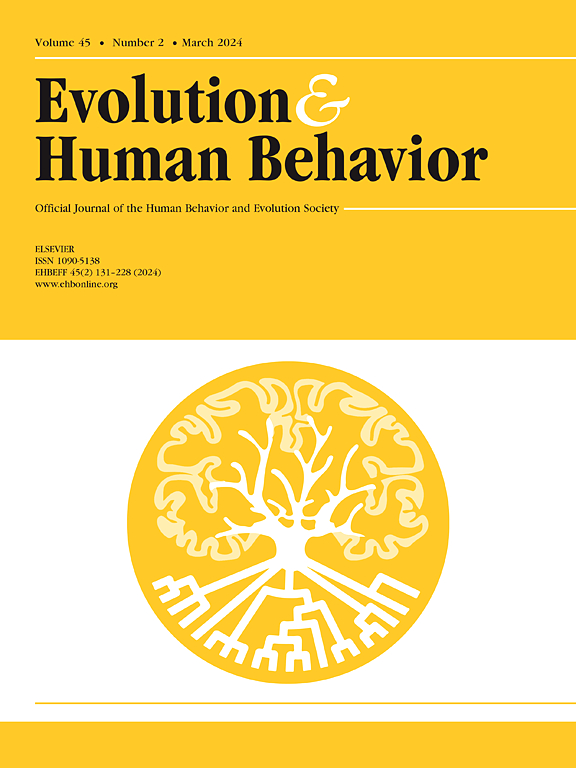Resource availability and experiences of partner violence shape facial masculinity preferences in Colombian women
IF 3.2
1区 心理学
Q1 BEHAVIORAL SCIENCES
引用次数: 0
Abstract
Women's preferences for facial masculinity in men are influenced by individual and socio-contextual factors that help balance costs-benefits in pursuit of well-being. This study explored how Colombian women's preferences for masculinized male faces are influenced by relationship context and resource availability, as well as their individual experiences of intimate partner violence (IPV). Using a forced-choice paradigm with eye-tracking, we assessed visual attention and face-choice in 293 cisgender heterosexual Colombian women recruited through social media adverts. Participants were assigned to either a high or low resource availability condition and selected preferred partners for short- and long-term relationships. Self-reported IPV experiences were also collected. Results revealed a strong preference for masculine faces in both relationship contexts, with higher preference in long-term scenarios and under low resource availability. However, higher frequencies of physical IPV predicted a lower preference for masculinity, particularly in long-term and high-resource contexts. These exploratory findings suggest that while Colombian women generally favor masculine traits, socio-contextual factors, such as resource availability and IPV experiences, significantly modulate these preferences. The study highlights the complex interplay between individual, evolutionary, and socio-ecological factors in shaping mate preferences, suggesting that masculinity is valued depending on relationship goals, resource conditions, and individual experiences like IPV.
资源可用性和伴侣暴力的经历影响了哥伦比亚女性对面部男性化的偏好
女性对男性面部阳刚之气的偏好受到个人和社会背景因素的影响,这些因素有助于在追求幸福的过程中平衡成本和收益。本研究探讨了哥伦比亚女性对男性化男性面孔的偏好如何受到关系背景和资源可用性以及她们个人亲密伴侣暴力经历的影响。利用眼球追踪的强迫选择范式,我们评估了293名通过社交媒体广告招募的哥伦比亚异性恋女性的视觉注意力和面部选择。参与者被分配到资源可用性高或低的条件下,并选择短期和长期关系的首选合作伙伴。还收集了自我报告的IPV经历。结果显示,在两种关系情境中,女性都对男性面孔有强烈的偏好,在长期情境和低资源可用性情境中,偏好程度更高。然而,身体IPV的频率越高,对男性气质的偏好就越低,尤其是在长期和资源丰富的环境中。这些探索性发现表明,虽然哥伦比亚女性普遍偏爱男性特征,但社会背景因素,如资源可用性和IPV经历,显著调节了这些偏好。该研究强调了个体、进化和社会生态因素在塑造择偶偏好方面的复杂相互作用,表明男性气概的价值取决于关系目标、资源条件和个人经历(如IPV)。
本文章由计算机程序翻译,如有差异,请以英文原文为准。
求助全文
约1分钟内获得全文
求助全文
来源期刊

Evolution and Human Behavior
生物-行为科学
CiteScore
8.30
自引率
9.80%
发文量
62
审稿时长
82 days
期刊介绍:
Evolution and Human Behavior is an interdisciplinary journal, presenting research reports and theory in which evolutionary perspectives are brought to bear on the study of human behavior. It is primarily a scientific journal, but submissions from scholars in the humanities are also encouraged. Papers reporting on theoretical and empirical work on other species will be welcome if their relevance to the human animal is apparent.
 求助内容:
求助内容: 应助结果提醒方式:
应助结果提醒方式:


